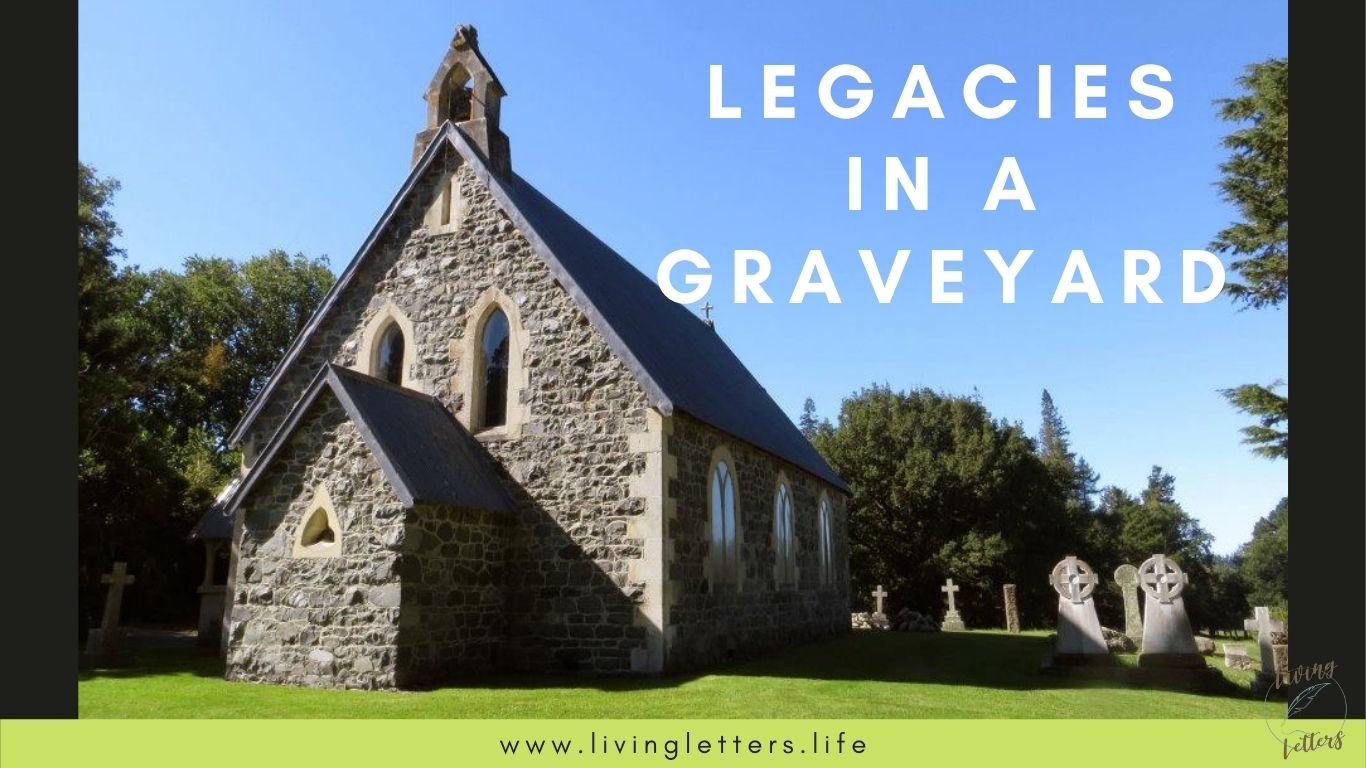
“For everything there is a season, and a time for every matter under heaven,” according to Ecclesiastes 3, including a time to die. Though we do not know the exact time of our deaths, we live knowing that after a few short years, we will no longer walk this earth. We are warned throughout scripture to be ready for that day, but we may not spend much time in thought about it until it comes inevitably close.
Sydney Carton, in A Tale of Two Cities, wakes up knowing that he will die “today” and prepares for it and comforts himself with Jesus' words in John 11: “I am the resurrection and the life. Whoever believes in me, though he die, yet shall he live.” His last hours are his best legacy, as he rolls along in a cart to the guillotine, holding fast to his belief that Jesus is the resurrection and the life. Even though Sydney is a fictional character, we remember him for his brave deeds before he died.
After death, we leave no further mark on this earth. Only what we have done while living will be remembered, and only by those whose lives we have somehow impacted—whether it be many, some, a few, or even none.
Epitaphs on grave markers sometimes give some indication about who lies buried beneath the ground, what they are remembered for, possibly their hope in death, or some other philosophical idea. My daughter told me about a gravestone she saw in New Zealand that had this observation inscribed: “You are not alone but linked to everything around you.” In some way, each of us is building on something that we will one day leave behind.
“ Though we do not know the exact time of our deaths, we live knowing that after a few short years, we will no longer walk this earth. ”
Years ago, my daughter and I visited the Cemetery outside Trinity Church in lower Manhattan. Among others buried there is Alexander Hamilton under a marker which reads: “The Patriot of incorruptible integrity. The soldier of approved valour.” Inside the church is a museum which describes his final hours—how in his last moments he had to recant the foolishness of the duel which led to his death in order to be received by the church for burial in that cemetery.
I've been intrigued by gravestones and cemeteries all my life. Maybe it is due to the fact that their graves are all I have ever known of one set of my grandparents, and an aunt and uncle. My mom kept flowers growing on their graves from spring to fall—a tradition that is quickly waning by millennials. So, to illustrate more effectively the wisdom or foolishness hidden away within the gates of cemeteries, I decided to visit some to write this blog—precisely three old ones in three different states.
Old City Cemetery in Lynchburg, Virginia, founded in 1806, was my first stop. There are graves of Revolutionary War soldiers with the writing so eroded, that it is impossible to read them. A Confederate section contains the graves of 2,200 Confederate soldiers from 14 states, including some slaves that chose to fight for the south. Also on the property is a museum where once a “pest house” treated Civil War soldiers from both sides suffering from the many “pestilences” that they endured during that bloody war.
I wandered through these areas and outside of them to spot some readable epitaphs. Rev. William Thomas Hall who died in 1933, pastored two Baptist churches, one in Philadelphia, Pennsylvania and another in Danville, Virginia. On his grave it said that “He endured as seeing him that is invisible.”
“ I am the resurrection and the life. Whoever believes in me, though he die, yet shall he live. ”
“Asleep in Jesus” was common in all the cemeteries I visited. Selena A. Glaaman's grave marker reads: “Resting till the resurrection morn,” and Blanche Davis' says, “Weep not, she is not dead, but sleepeth.” I think my favorite might be that of James Edward Bowler who died confidently at the age of 86 believing as did Job, “I know that my redeemer liveth.”
The headstone of one cluster of family graves marks the final resting place of the family patriarch. Its epitaph cites Acts 13:36, “After he had served his own generation by the will of God, fell asleep and was laid unto his fathers.”
Other gravestones focused more on the attributes of the person lying in the grave: “None knew thee but to love thee” and “She was the sunshine of our home.”
My next stop was a cemetery in Belvidere, New Jersey, where General Robert McAllister (1813-1891) is interred and whose monumental grave marker lists all the Civil War battles he took part in, finishing with this epitaph: “He fought the good fight. He kept the faith.” Research into this Union General reveals that on:
“the second day of the Battle of Gettysburg, Lt. Col. Robert McAllister's Eleventh New Jersey Regiment was part of Brig. General J.B. Carr's First Brigade, in Brig. General A.A. Humphrey's Second Division of Maj. General Dan E. Sickles' Third Corps, Army of the Potomac. Col. McAllister (H02-3-6-5) was born in 1813, near McAlisterville, PA. He and his brother Thompson were members of their local Pennsylvania militia when they were young men. In the 1850s Thompson moved to Virginia, where he became sympathetic with the Southern cause. When war broke out in 1861, Thompson became a captain in the Virginia artillery, while Robert raised the 1st New Jersey Infantry Regiment, and was elected its commanding officer. Although they were not aware of it at the time, they [Robert and Thompson] were on opposite sides at the Battle of Bull Run (First Manassas) on April 1861. Thompson had to retire from the Confederate Army before the war's end because of sickness, but Robert remained on active duty. He fought in every major battle of the Army of the Potomac, except Antietam, and was present at Appomattox as a Division Commander, with the rank of Brevet Major General” (http://www.clanmcalister.org/gettysburg.html).
Further down the row of graves lies Israel Harris, Esq. who died in 1891 and was “a friend of the fugitive slave” according to his grave stone. Another of his relatives a few graves further, “Died in peace in the faith of the Christian surrounded by friends and respected by all.” Rev. Sylvanus Nye Hutchison, died 1910, “A sinner saved by grace.”
“ I think my favorite might be that of James Edward Bowler who died confidently at the age of 86 believing as did Job, 'I know that my redeemer liveth.' ”
Catherine Hazlett who died in 1890 and Philip Quick in 1889 may or may not have known each other, but their grave stones bear the same words from Revelation 14:13, “Blessed are the dead which die in the Lord.” And a married couple with the last name of Craig have inscribed on their joint headstone, “God is love.”
One other interesting grave was that of Seldon T. Scranton who died in 1891. He was the founder of Scranton, Pennsylvania, his gravestone reads. Seldon and his brother George began the operation that in 1840 became the Lackawanna and Coal Company, in the very area that 26 years later became the City of Scranton.
The cemetery located next to the Shawnee Presbyterian Church in Shawnee, Pennsylvania was the last and oldest cemetery I visited. It began when the church was founded in 1752. The sign that greeted me at the entrance reads, “The Eternal God is your resting place.”
“ Further down the row of graves lies Israel Harris, Esq. who died in 1891 and was “a friend of the fugitive slave” according to his grave stone. ”
Just inside the gate lie Abraham and Susan Friese. He left this life in 1884, she in 1886. On their joint grave marker is a poem, difficult to make out now, but very hopeful for Christians:
“Asleep in Jesus blessed sleep,
From which none ever wake to weep.
A calm and undisturbed repose,
Unbroken by the last of foes.”
More recently, on Michael James Howell's gravestone, is inscribed, “Thus shall we be truly blest both in labor and rest.”
Behind the church and inscribed on the bottom of the back wall are the grave markers of the DePuy family, who were also the founding members of Shawnee Presbyterian Church as well as the nearby town of Shawnee. Nicholas DePuy built his home at the edge of the Delaware River. With help from Benjamin Franklin, his house later became Fort DePuy of the French and Indian War. Nicholas and his wife had ten children who served the Shawnee congregation, as did several of the grandchildren and later descendants. Notable inscriptions on the grave markers include for Ann DePuy Erg, “Forever with the Lord;” and a young Benjamin DePuy who died in 1806 at the age of 23, “Kind and dutiful son, Affectionate brother, Generous friend.”
Another marker which has been added in recent years, probably because the original was not readable anymore, reads:
“Here Lies Captain Philipp C. Shrawder
Born in Worms, Germany, Dec. 6, 1745
He was an officer in the Continental Army during the American Revolution and crossed the Delaware with George Washington on Dec. 25, 1776. Philipp moved to Shawnee in 1782 and served the people of NE PA until his death on Mar. 17, 1820
Ruhe in Frieden (translation: Rest in Peace)”
“ “Asleep in Jesus blessed sleep, From which none ever wake to weep. A calm and undisturbed repose, Unbroken by the last of foes.” ”
It was encouraging to me to read so many headstones with scripture or other words indicating that these believers took their last opportunity (if, in fact, they requested these inscriptions before their deaths) to be remembered by words that spoke of their faith in God and Jesus Christ. But maybe, the most poignant epitaph of all known to me, is another that my daughter saw in the cemetery in New Zealand:
“Chip By Chip,
Chip By Chip,
The Stone is Diminished;
Bit By Bit,
Bit By Bit,
The Figure is Finished;
The Carver who Sculptured it
A Crucifix Imaged.
“Chip by Chip,
Chip by Chip,
Sin is Diminished;
Bit By Bit,
Bit By Bit,
Jesus' Life Imaged;
Even in Us May it
Fully Be Finished.”
And so, by God's grace, it shall be!
“For if we live, we live to the Lord, and if we die, we die to the Lord. So then, whether we live or whether we die, we are the Lord's. For to this end Christ died and lived again, that he might be Lord both of the dead and of the living” (Romans 14:8-9).


Send Me A Message